Equity & Diversity Annual Report – 2006 Section 2: Human Resource Policies and Practices
This section reports on policies and practices in relation to recruitment and selection, training and development, and employment policies from a diversity perspective.
Section 2.1: Recruitment & Selection
General Recruitment
The RBA continues to be regarded as an attractive place of employment for high calibre candidates many of whom join through the annual graduate, cadetship and traineeship recruitment programs. However, the Bank also attracts high quality recruits from overseas, a number of whom joined the staff during the year. Several initiatives have helped to provide employment opportunities to high school and university students. There has been a continuing emphasis on attracting more female candidates to the Bank. Although online remains the preferred method for applicants to receive information and to apply for positions, the option of forwarding and receiving written applications still remains.
Graduates and Cadets
Both the graduate and cadetship recruitment campaigns at the RBA continued to provide high quality applicants to departments. Opportunities were again advertised in the national press, graduate publications and web-based job boards and graduate career information sites, including those provided by university careers services. Graduate information packs were sent to honours students at universities Australia‑wide.
The RBA continued its participation in The Australasian Graduate Recruitment Benchmarking Study. This provides information on graduate recruitment practices in over 100 organisations in Australia and New Zealand and assists in maintaining a best practice approach to graduate recruitment.
Graduate Development Program
Graduates who join the RBA's two year Graduate Development Program (GDP) mostly have honours or higher level studies in economics, finance or closely related studies. Most graduates are recruited through the annual graduate recruitment program commencing in March, and from students completing the RBA Cadetship Award. The Bank also recruits information technology graduates to the program.
Thirty-six graduates began the Graduate Development Program in 2006. This represented around a third of all new employees. The intake included 13 students from the 2004/05 Cadetship Award which continues to play a significant role in attracting exceptional graduates to the RBA. Twenty four per cent of the graduates are women, a decrease in comparison to the 38 per cent recorded in 2004/05 but consistent with the trend of earlier years.
Cadetship Award
Pre-employment programs are becoming an increasingly important part of recruitment efforts at the graduate level. The RBA's Cadetship Award provides two months of work experience to students who have completed, to a high standard, a minimum of three undergraduate years of study. Financial support is provided during the honours year for cadets who are offered and accept a place on a future Graduate Development Program.
In 2005/06, 162 applicants were interviewed (101 men and 61 women) and 18 were accepted. Four were female and 14 were male. When compared to last year's intake, the number of female applicants fell by 18 per cent.
AXISS Scholarship Program
Participation in the AXISS Scholar Program continued in 2005/06. The Program is a government initiative administered by AXISS Australia (a division of Invest Australia), which facilitates partnerships between industry and universities to promote excellence in finance education. The Program provides an opportunity for talented finance or commerce students to undertake ten to fourteen weeks' paid work experience in the financial services industry. The scholarship is another effective way to source high calibre graduates and cadets for the Bank's Financial Markets Group. In 2005, the RBA accepted two AXISS scholars. Owing to declining sponsorship and other factors, the Government has decided that the program will cease at the end of the current year.
Information Technology Graduates
During the year, Systems and Technology Department continued to be involved in placing students undertaking IT studies through an Industrial Training Program. Each student completes a twelve-month paid work placement as part of their degree. The RBA continues to successfully place students from this program into the cadetship and graduate programs. Five of the 36 graduates recruited to the 2006 Graduate Development Program were for the Systems and Technology Department (4 men and 1 woman). This compares with only two graduates from the Systems and Technology Department in 2005.
Traineeships
For the past 20 years, the RBA has supported the Australian Government's New Apprenticeship and Traineeship System. Twelve-month traineeships are offered in Business Administration, Print Design, and Information Technology.
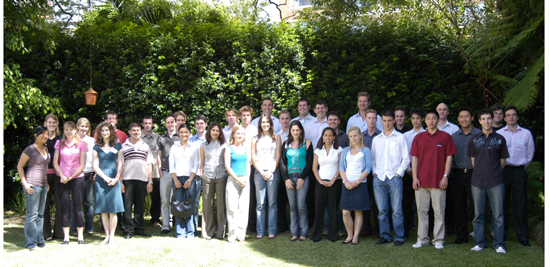
Business Administration Traineeship
Business Administration trainees undertake off-the-job training one day per week towards a Certificate III in Business Administration. The training is conducted on the RBA's premises. Trainees rotate through three departments, spending approximately four months in each. Every year, at least one Business Administration Traineeship placement is targeted at people with a disability and one at Indigenous Australians.
All of the 10 Business Administration trainees successfully completed the 2005 traineeship. The group consisted of 5 men and 5 women and included one person with a disability and one Indigenous Australian. Seven of the trainees gained full-time permanent employment with the RBA. A further 10 trainees (6 women, 4 men) were recruited in March for the 2006 program.
Print Design Traineeship
Each year the RBA offers one Print Design Traineeship. The trainee undertakes training one day per week towards a Certificate II in Printing and Graphic Arts (Print Design). The training is undertaken off-the-job at Ultimo TAFE. In 2005, the Print Design Traineeship was successfully completed by a woman. The traineeship was again offered in 2006 and a woman is currently undertaking the program.
Information Technology Traineeship
Information Technology (IT) trainees undertake training off-the-job one day per week. Four traineeships were offered in 2005 (3 men and 1 woman). The trainees are currently studying towards a Certificate IV in Information Technology (Network Management).
Section 2.2: Staff Training & Development
General Training
During 2005/06, 455 staff (52 per cent of all staff) attended some formal in-house training. This comprised 267 men and 188 women (53 per cent men and 41 per cent women). These figures exclude e-learning programs which are available to all staff throughout the year.
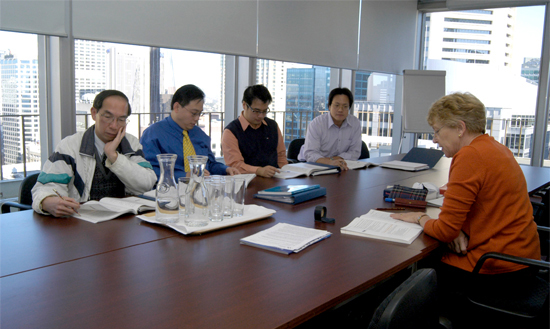
A number of new programs were trialed during 2005/06, including two mental health awareness workshops. The first workshop was attended by 25 staff and the second by 35 managers/supervisors. Lunchtime well-being workshops are also being considered for implementation late this year.
The RBA continued to provide ongoing Occupational Health & Safety training. A total of 145 RBA staff attended OH&S workshops. In addition, 54 senior staff (11 women and 43 men) participated in presentations on the legal responsibilities of managers for OH&S in the workplace.
Externally, Springboard continues to be offered, with 11 women attending the program during 2005/06. Other women's career management programs offered through the year include Career Resiliency and Xplore. One woman staff member has already completed Xplore whilst another woman staff member is currently participating in the Women in Finance mentoring program.
Staff Appraisal
Training and development issues continue to be a focus of the development plans incorporated last year in the RBA's staff appraisal form. The Bank also uses a 360 degree feed back tool in the graduate program and this year one functional group also decided to undertake a 360 degree feedback exercise. Specific management competencies will be highlighted and used for development purposes.
Graduate Development Program
The Graduate Development Program provides extensive training and development opportunities as well as a strong foundation for longer-term professional development. The two-year formal training schedule aims to develop graduates' skills in the areas of computer applications, business writing, interpersonal skills, technical skills, professional presentations, time management, leadership and career management.
The program is reviewed every year and continues to be modified to meet changing needs. This year, a new session was offered on communication skills and a business writing refresher workshop was also included. Graduate orientation week was also modified with self-development workshops and a stronger emphasis on building a social support network between graduates. An interactive health session was also included this year which incorporated a basic health assessment covering essential nutrition and exercise.
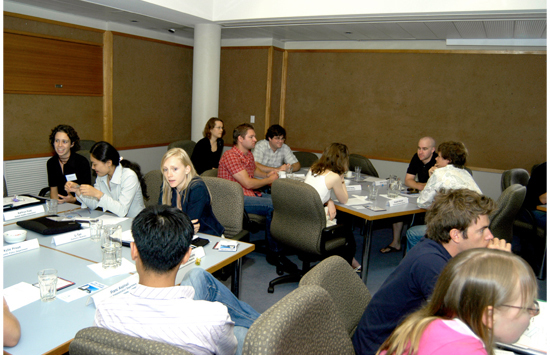
Management Programs
In 2005, a total of 16 staff (10 men, 6 women) attended the Central Banking Management Program. The Program is one of the Bank's most senior development programs and in total 111 staff members have attended since its inception in 1996.
The New Managers Program captures staff who have recently been promoted to manager level. In 2006, there were 51 participants (36 men and 15 women) an increase of 23 staff from last year.
An Executive Development Program was developed and trialed during the year. This program was designed to incorporate a range of development options for the Bank's senior management group. Five senior staff attended external leadership programs and 10 attended an internal program to develop executive presentation/media skills. A further 13 senior staff (7 men and 6 women) attended an external leadership forum. It is envisaged the program will continue to explore a wider range of executive development opportunities.
E-Learning
The RBA's extensive e-Learning program was reviewed this year. It now caters for a more flexible training arrangement with an overall reduction in online training and an increase in face-to-face sessions.
A specialised financial training program (Zoologic) was trialed this year and is currently being reviewed and evaluated for future use. A new online training initiative, the ‘LearningRoom’ was also introduced. This is designed to offer a further flexible training option to deliver information ‘just-in-time’ via email and is being used to improve induction and orientation programs for staff. A privacy module was introduced this year to the orientation program.
Educational Qualifications
Sixty-seven per cent of staff were recorded as having a post-secondary or tertiary qualification for this reporting period, the same as in 2003. Of those staff who have a post-secondary or tertiary qualification, 27 per cent hold a post graduate qualification, the same as last year. Overall, 52 per cent of staff now hold a Bachelor Degree or higher.
Since 2002, the gap between men and women holding post-secondary qualifications has steadily been closing. In 2002, the gap was 19 per cent reducing to a 15 per cent gap in 2005 and 12 per cent this year. A significant gap still exists in post graduate qualifications where only 13 per cent of women this year held them, compared to 23 per cent of men.
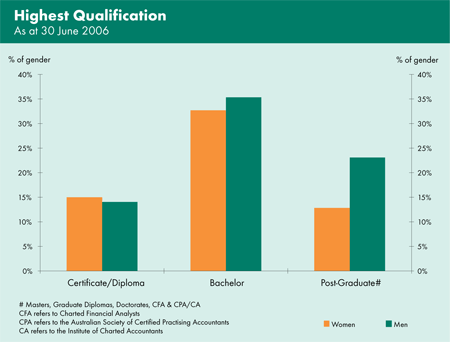
Study Assistance
Employees are encouraged to obtain qualifications of value to the RBA and relevant to their career. To assist staff in obtaining these qualifications, the RBA has a study assistance scheme where tuition fees are met by the RBA on successful completion of course subjects.
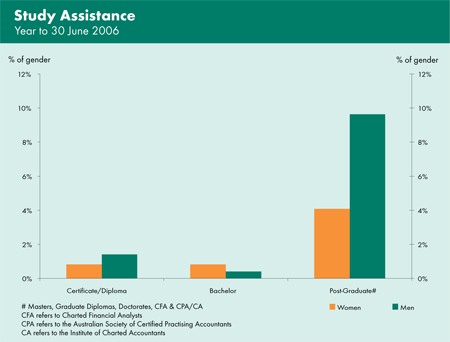
In 2005/06, 78 staff received study assistance (9 per cent of staff), little changed from 2004/05. Of these, 26 per cent were women (a rise of 3 per cent). Overall, 21 women (6 per cent of women in RBA) received study assistance of whom 15 have undertaken post-graduate study. The percentage of men who received assistance was 11 per cent, a slight decrease. The majority of staff (80 per cent) who received study assistance were studying at the post-graduate level. The gap between the number of men and women undertaking post-graduate study narrowed slightly in 2006.
2006 Bank Study Assistance Committee




2006 Part-Time Study Award Recipients






Post-Graduate Study Award
An important element of the RBA Study Assistance Scheme is the Post-Graduate Study Award (PGSA). This is offered each year to assist a small number of high calibre staff undertake full-time post-graduate study in relevant disciplines at universities in Australia or overseas. The PGSA represents a substantial investment by the RBA in upgrading the knowledge and skills of staff.
A total of 89 RBA staff have participated in the PGSA program. In 2006, the Bank Study Assistance Committee approved 6 full-time (3 men and 3 women) PGSA's. Six applicants for part-time study (5 men and 1 woman) were also successful. Three of the full-time PGSA award recipients are to commence studying at overseas institutions; they will commence their studies in 2006/07.
2006 PGSA Recipients






Certificate IV in Business Administration
The RBA continued to assist clerical staff in obtaining Certificate IV qualifications in Business Administration. For Head Office staff, the training was changed from one day a month to a half-day per fortnight, but remains over 12 months and continues to be conducted on the RBA's premises. Five staff (3 women and 2 men) were studying towards the qualification during the reporting period. A further seven staff (4 men and 3 women) commenced the study program in 2006.
Section 2.3: Employment Policies
This year, the RBA has implemented various initiatives agreed under the 2005/06 enterprise bargaining arrangements and has progressed consideration of other initiatives from the previous Workplace Diversity Plan. New areas of focus for employment policy included staffing policies for a business recovery site due to open at Norwest Business Park, Sydney, early in 2007/08. The RBA has also developed policies and procedures to meet its obligations to employees regarding superannuation in light of recent changes to related Commonwealth Government legislation.
Flexible working arrangements
Work continued on developing flexible working arrangements that would accommodate both the special needs of staff and the operational needs of the Bank in an emergency such as a flu pandemic. Work has commenced on developing a policy for staff wishing to continue working with the Bank but transitioning to retirement. Improvements were made to remote access to the Bank's computer systems and a policy developed to encourage some staff to install broadband internet connections at home.
Superannuation
In line with the introduction of Choice of Fund legislation, the Bank began offering choice of superannuation fund to employees in July 2005. Employees were given the option of remaining members of the Reserve Bank of Australia Officers' Superannuation Fund (OSF), the Bank's default fund, or electing to choose another fund. Members of the OSF are also permitted to split contributions made to their OSF accumulation accounts from 1 January 2006 with their spouse. This arrangement will assist families to maximize the benefits available in superannuation and provide an avenue for spouses to share in superannuation benefits.
Enterprise Bargaining
During the year, a new two year enterprise agreement between the RBA and the Finance Sector Union was certified by the Australian Industrial Relations Commission and implemented. It has a notional end date of 31 December 2006. Under the agreement, the RBA has:-
- Introduced an option for maternity leave to be taken at half pay;
- Extended paid paternity leave from one to two weeks;
- Increased the guaranteed period of part-time work available after parental leave from six to twelve months;
- Allowed employees to use their accrued personal leave for pre-natal medical consultations; and
- Prepared for introduction from mid-2006 of an Employee Assistance Program whereby employees will have access to professional guidance and counselling to assist them address personal and work related issues potentially affecting work performance.
Last year changes to performance appraisal and performance pay arrangements for EBA-covered staff were implemented. A new ranking scale provides for a percentage increase paid on actual salaries providing scope for more flexible rewards with the same budget constraints as in the past. In 2005/06, average performance pay outcomes were similar for men, women, people from a non-Engish speaking background, and people with disabilities.
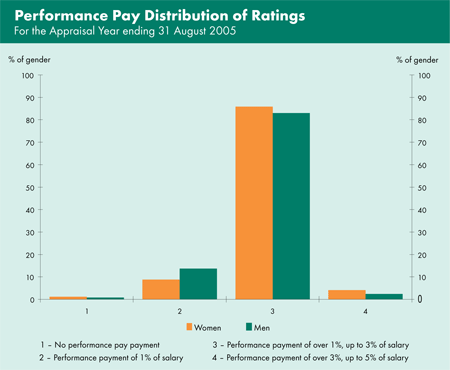
Consultation
The principal means of providing information to staff about equity & diversity issues are via: Staff Matters, the staff newsletter, Currency, the monthly staff magazine and the Personnel Department intranet site.
The Equity & Diversity Report 2005, was distributed to staff via email, placed on the RBA's intranet and hard copies made available on request. Consultation with workplace unions continued during the year on various matters, including finalisation of new enterprise agreements, OH&S issues and proposed staffing arrangements at the RBA's business resumption site.